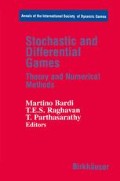Abstract
In this chapter we announce a result on computing a set of stationary equilibrium strategies of the players in a n-person nonzero sum discounted stochastic game in which the transition probabilities depend on the actions of a single player by formulating the problem as a linear complementarity problem that can be solved by Lemke’s algorithm. This result has been published elsewhere. See Mohan, Neogy, and Parthasarathy in Complementarity and Variational Problems—State of Art, edited by M.C. Ferris and J-S. Pang (SIAM Philadelphia, 1997) 284-294.
Access this chapter
Tax calculation will be finalised at checkout
Purchases are for personal use only
Preview
Unable to display preview. Download preview PDF.
References
C. E. Lemke. “Bimatrix equilibrium points and mathematical programming,” Management Sci., 11, pp. 681–689, 1965.
A. S. Nowak and T. E. S. Raghavan. “A finite step algorithm via a bimatrix game to a single controller nonzero-sum stochastic game,” Mathematical Programming, 59, pp. 249–259, 1993.
T. Parthasarathy and T. E. S. Raghavan. “An orderfield property for stochastic games when one player controls transition probabilities,” J. Optimization Theory and Appl., 33, pp. 375–392, 1981.
M. J. Sobel. “Noncooperative stochastic games,” Ann. Math. Stat., 42, pp. 1930–1935, 1971.
Author information
Authors and Affiliations
Editor information
Editors and Affiliations
Rights and permissions
Copyright information
© 1999 Springer Science+Business Media New York
About this chapter
Cite this chapter
Mohan, S.R., Neogy, S.K., Parthasarathy, T. (1999). On Linear Complementarity and A Discounted Polystochastic Game. In: Bardi, M., Raghavan, T.E.S., Parthasarathy, T. (eds) Stochastic and Differential Games. Annals of the International Society of Dynamic Games, vol 4. Birkhäuser, Boston, MA. https://doi.org/10.1007/978-1-4612-1592-9_10
Download citation
DOI: https://doi.org/10.1007/978-1-4612-1592-9_10
Publisher Name: Birkhäuser, Boston, MA
Print ISBN: 978-1-4612-7208-3
Online ISBN: 978-1-4612-1592-9
eBook Packages: Springer Book Archive

